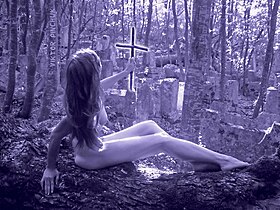Basics of fine-art photography/Creating works in conceptual photography

Conceptual photography is a genre (type, style) of photographic art, where the author develops original (peculiar, unusual) ideas for subsequent implementation in his own works.
General information
[edit | edit source]The genre has points of contact with staged photography; conceptual works are distinguished by extravagance and unusuality; sometimes there are present elements of surrealism and minimalism.
At the origins of this genre lies conceptualism, a creative movement that emerged in the 1960s, whose proponents argued that an object becomes a work of art not because it has aesthetic values, but primarily due to the desire of the author (that is, at the artist, in a generalized sense of the word). Probably the first experimental works with a conceptual bent were made much earlier than the period mentioned above.
Conceptual photography is usually staged, but, theoretically, it can be random — when author, seeing a “scene” worth capturing, instantly directs the lens and presses the button.
Step-by-step instruction
[edit | edit source]- Mentally create a sketch.
- Prepare everything that is required to implement the idea: paraphernalia, decoration elements, participants (if any will be involved in the plot), not forgetting the correct location of the light source (s).
- Make sure that composition corresponds to the set theme and looks aesthetically pleasing.
- Need a previsualization of the scene, that is, a preview before shooting, rough animation sketches, allowing you to experiment with the arrangement of objects and participants, lighting, camera positioning — to be able to choose the best option.
- Post-processing also plays a role: elements of different images can be combined into one.
- The name of a photographic work (also like the title of a book or a movie) should smoothly “glide” along the plot, not revealing the meaning directly.
- It is important that your work makes the viewer think. The purpose of conceptual art is not to display an idea, but to encourage reflection through photography.
The photographs by the author of this textbook, presented in the gallery, will help you become visually familiar with the topic you are studying.
Gallery
[edit | edit source]-
The window of life (2013)
-
Eternal light (2009)
-
Repentance (2009)
-
Countdown (2010)





